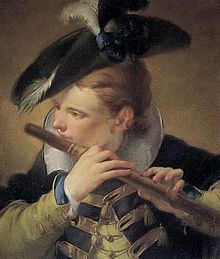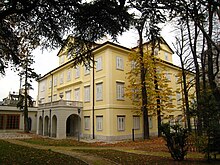Museo Sartorio
The Civico Museo Sartorio (Municipal Museum Sartorio) is a museum in Trieste . It was founded from the estate of the Sartorio family and today includes, in addition to the family's original living rooms from the 19th century, a comprehensive collection of paintings, sculptures, ceramics and porcelain. The most important works in the museum include the triptych of Saint Clare by Paolo Veneziano and probably his son Marco from the 14th century, as well as paintings and drawings by Giovanni Battista Tiepolo and his son Giandomenico Tiepolo from the 18th century.
location
The museum is located in the Villa Sartorio on Largo Papa Giovanni XXIII in the Borgo Giuseppino district .
history


Building history
The area around today's Villa Sartorio was outside the city wall in the 17th century and was called Borgo Santi Martiri ( Suburb of the Holy Martyrs ). It was largely owned by various Catholic orders. In 1786 the Città Giuseppina (now Borgo Giuseppino ) was founded on the site of the Borgo Santi Martiri . It is believed that the palace was built in 1791 on the foundations of a monastery. The floor plan of the building refers to Venetian models, in particular Palladio . The palace was rebuilt several times. The building got its current, classical appearance between 1820 and 1838 by the architect Nicolò Pertsch, the son of Matteo Pertsch . During the renovation work, Carlo d'Ottavio Fontana (1774–1832) from Trieste acquired the building in 1832, which was assigned to his three children upon his death. In 1836 Fontana's daughter Giuseppina (1814–1904) paid off her two brothers and became the sole owner of the palace.
Transfer to the Sartorio family
Via Giuseppina Fontana, who married Pietro Sartorio (1796–1890) in 1834 , the villa came into the possession of the Sartorio family . After Giuseppina's death, her son Giuseppe Sartorio (1838-1910) inherited the building, which in 1911 passed into the possession of his sister Paolina Sartorio (1837-1923) and niece Anna Sartorio Segrè (1861-1946). In 1923 Anna became the sole heir of the property as the last member of the Sartorio family.
During and after the Second World War
In 1943 the villa was occupied by German troops and then by Yugoslav partisans . After the Allied forces entered Trieste in 1946, the ground floor, the second floor and part of the roof structure were used by the US troops as a school for around 150 children of American officers stationed in Trieste and as accommodation for the teachers.
Creation of the museum
Anna Sartorio Segrè (1861–1946), the granddaughter of Pietro and Giuseppina Sartorio and the last member of the family, bequeathed the palace, the furnishings, paintings, porcelain and other works of art to the city of Trieste on her death in 1946, so that it could become a museum. The inventory of the estate lasted from June 27, 1946 to February 10, 1947 and included, among other things, 350 paintings, 189 prints, 3,028 individual pieces of ceramics, 8,000 books and 726 pieces of furniture totaling over 50 million lire . With the exception of a few pieces that were given to the nephew and adopted son of Anna Sartorio Segrè, all furnishings became the property of the municipality of Trieste on February 3, 1947. The building was not handed over to the city until December 18 of the following year. Although the ground floor, the second floor and part of the roof structure continued to be used as a school by the Allied forces, the first five exhibition rooms on the first floor were opened on September 2, 1949. On the same floor, Salvatore Segrè Sartorio , Anna Sartorio Segrè's widower, lived in some rooms that were not open to the public. After Segre's death in June 1949, the museum was expanded to include his previous living space and thus another room was added. In September 1953, the Allied forces finally left the building, which was fully opened to the public on March 18 of the following year.
Extension of the museum
During renovations in 1966, four halls on the first floor of the building, which had been used as guest rooms by the Sartorio family, were converted by historians Mario Mirabella Roberti and Bianca Maria Favetta into exhibition rooms that have since housed a collection of ceramics and porcelain. In the decades that followed, additional rooms were rebuilt for sometimes changing exhibitions, and the museum was thus continuously expanded to include collections and individual works that have come into the possession of the city of Trieste through donations. The most important collections of the city of Trieste that have been integrated into the museum rooms include:
- Rusconi-Opuich collection with around 2,500 paintings, prints, furniture, pottery and other objects, some of them antique (since 1986)
- Stavropulos collection with 150 paintings and sculptures from the 19th and 20th centuries (since 1994)
- Triptych of Saint Clare by Paolo Veneziano and probably his son Marco from the 14th century (since 1996)
- Fontana-Sartorio collection with drawings by Giovanni Battista Tiepolo and numerous antique objects, including approx. 300 pottery with Greek motifs (since 1998)
During the last renovation work between 2003 and 2006, the remains of a Roman house from the 1st century AD were discovered under the villa, which were integrated into the exhibition of the museum.
Individual evidence
- ↑ Lorenza Resciniti (1999): Il Civico Museo Sartorio di Trieste , 2nd edition (Rotary Club Trieste), Triest, p. 48.
Web links
Coordinates: 45 ° 38 ′ 46.4 " N , 13 ° 45 ′ 47.5" E

